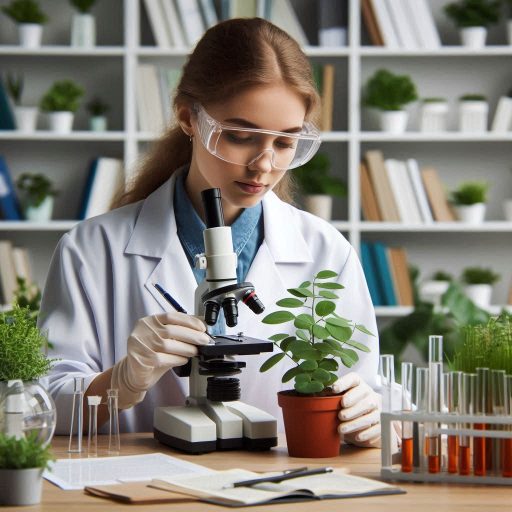Introduction
Fieldwork in plant science is essential for hands-on learning and practical experience.
It allows students to apply classroom knowledge in real-world settings.
Engaging in fieldwork helps students develop critical skills in observation, data collection, and plant identification.
Plant science students gain invaluable insights into ecosystems, plant behaviors, and environmental interactions through fieldwork.
This experience enhances their understanding of theoretical concepts and prepares them for future careers in the field.
Additionally, fieldwork fosters a connection with nature and local environments.
Students learn to appreciate biodiversity and the importance of conservation.
It also encourages teamwork and collaboration with peers and local communities.
This blog post will provide valuable tips for successful fieldwork in plant science.
Students will learn how to prepare effectively, stay safe, and document their observations.
They will discover techniques for collecting and preserving plant specimens and engaging with local communities.
By following these tips, students can maximize their fieldwork experiences.
They will be better equipped to tackle challenges and make meaningful contributions to plant science research and conservation.
Let‘s explore these essential strategies for effective fieldwork in plant science!
Preparing for Fieldwork
Fieldwork is a critical part of plant science studies, offering hands-on experience and real-world application of classroom knowledge.
Being well-prepared can make a huge difference in the success of your fieldwork and the quality of your research.
Research the specific area of study
Before heading into the field, conduct thorough research on the area you will be studying.
Familiarize yourself with the local plant species, climate, and environmental conditions.
Review previous research papers or studies conducted in that region to understand the ecological context better.
Knowing the types of plants and ecosystems you‘ll encounter will help you stay focused and efficient during fieldwork.
This research will also guide your observation strategy and help you identify rare or important species relevant to your study.
Pack appropriate gear such as field notebooks, hand lens, and plant identification guides
Packing the right gear is crucial for effective fieldwork.
A field notebook is essential for recording observations, taking notes, and tracking data in real time.
A hand lens is useful for examining small details, such as leaf structure or flower morphology, which are often critical for plant identification.
Plant identification guides, either as books or digital apps, are valuable tools to ensure accurate species identification.
Don‘t forget to pack other essential gear such as comfortable clothing, sturdy boots, sunscreen, and insect repellent, all of which contribute to a safe and productive day.
You should also consider bringing extra water and snacks to stay energized during long field sessions.
Coordinate with fellow students or professors for group fieldwork
Working in groups is often more efficient and safer than working alone during fieldwork.
Coordinating with fellow students or professors allows you to share tasks, equipment, and knowledge.
Group fieldwork enables better data collection since each person can focus on different aspects of the study.
For example, one person might focus on taking measurements while another focuses on plant identification.
This collaborative approach can increase productivity and ensure no important data is missed.
Additionally, working with experienced professors or peers can provide learning opportunities and insights that you might not gain while working solo.
Moreover, group fieldwork enhances safety, especially when working in unfamiliar or remote locations.
Having others around helps in case of emergencies or unexpected problems, like weather changes or equipment failures.
Before starting fieldwork, ensure clear communication within the team regarding objectives, roles, and meeting points.
Fieldwork is a fundamental experience for plant science students, helping them develop practical skills and knowledge.
Thorough preparation, the right tools, and collaboration with peers or mentors will lead to more productive and successful research in the field.
By staying organized and working efficiently, you can maximize the value of every fieldwork experience.
Read: Challenges and Rewards: The Dual Life of an U.S. Environmental Scientist
Understanding Safety Guidelines
Safety should be a priority for plant science students during fieldwork.
Proper safety practices ensure successful and accident-free research.
Familiarize yourself with safety guidelines and protocols
Before heading into the field, review the safety protocols relevant to your location and research activities.
Institutions often provide training that covers handling hazardous materials and understanding the environmental risks specific to your study area.
Make sure to familiarize yourself with safety guidelines concerning the proper use of tools and protective gear.
Knowing these protocols helps you prevent accidents and handle emergency situations with confidence.
Stay updated on the safety measures for any chemicals or equipment you plan to use during fieldwork.
Carry necessary safety equipment such as first aid kits and emergency contacts
Carrying essential safety equipment is critical to minimizing risks in the field.
A first aid kit should always be part of your gear, stocked with bandages, antiseptic wipes, pain relievers, and tools for treating minor injuries like cuts or scrapes.
For more specialized needs, such as allergies or chronic conditions, pack relevant medications.
Always have up-to-date emergency contact information on hand, including local authorities and field supervisors.
Communication devices, like mobile phones or satellite phones, are also important for contacting help if necessary, especially in remote areas.
Wearing the right protective clothing is crucial.
Long-sleeved shirts, durable pants, and boots help protect against insect bites, plant-related injuries, and harsh environmental conditions.
Gloves should be worn when handling unfamiliar or potentially dangerous plants.
Depending on the terrain, you may need helmets, goggles, or even high-visibility clothing for navigating challenging environments.
Stay updated on weather conditions and potential hazards in the field
Staying informed about weather conditions is vital for safe and efficient fieldwork.
Extreme weather, such as storms or high winds, can pose significant risks.
Always check the forecast before going out and monitor weather updates while in the field to avoid getting caught in dangerous situations.
Ensure you are prepared to act quickly if weather conditions deteriorate, which may mean postponing fieldwork if necessary.
In addition to weather, knowing the environmental hazards in your area is crucial.
Some ecosystems may contain dangerous wildlife, poisonous plants, or unstable terrain.
Understanding these risks helps you prepare accordingly, whether it‘s by bringing additional safety gear, altering your fieldwork plan.
This allows you to focus on conducting meaningful research without compromising your safety.
Read: Job Market Trends: Future of Chemistry Jobs in America
Observing and Documenting Plant Species
Fieldwork in plant science requires sharp observation and precise documentation skills.
Developing these skills is essential for accurate research and analysis.
Practice careful observation skills and note-taking techniques
Careful observation is critical when studying plants in the field.
Train your eyes to notice subtle details, such as leaf patterns, stem structures, and flower arrangements.
Always take time to examine each plant from different angles to capture as many features as possible.
Observing seasonal changes, growth stages, and environmental interactions gives valuable insights into plant behavior and adaptation.
Develop a habit of documenting every observation immediately.
Take detailed notes on location, plant characteristics, weather conditions, and anything unusual you notice.
Precise, consistent note-taking helps you track patterns and enhances data accuracy for future research.
Keep your field notebook organized by using specific headings, such as “Date,” “Time,” “Location,” and “Observations.”
Use short sentences or bullet points to avoid missing important details.
If possible, sketch the plants you observe, focusing on key characteristics like leaf shapes and flower structures.
These drawings serve as valuable references later when comparing species.
Consistent and thorough documentation makes data collection more reliable and professional.
Learn how to identify common plant species in the field
Identifying plants accurately is essential for plant science students.
Start by learning how to identify common plant species in your research area.
Study the physical characteristics of various plants, such as leaf arrangements, flowers, and fruits.
Learning the differences between species becomes easier with practice.
Pay attention to unique features like bark texture, seed pods, or root systems that help differentiate plants.
Focus on mastering local species first, then gradually expand your knowledge to include more diverse plant families.
Familiarize yourself with key plant classification systems, such as family, genus, and species.
Understanding the taxonomy of plants helps you identify related species more quickly and accurately.
For example, knowing that plants in the same family share certain traits allows you to recognize related species even in unfamiliar environments.
Knowledge of plant classification also enhances your understanding of plant evolution and ecological relationships.
Use a field guide or smartphone apps for plant identification
Field guides and smartphone apps are invaluable tools for plant identification.
Traditional field guides provide detailed illustrations and descriptions that make it easier to identify plants on-site.
Choose a guide that covers the plant species in your specific area.
Compare the plant you observe with the guide‘s illustrations to ensure accuracy.
Mark the pages of frequently encountered species for quick reference.
Smartphone apps also offer powerful plant identification tools.
Many apps use image recognition technology to identify plants based on photos you take.
Simply upload a photo, and the app will suggest possible species matches, making identification faster and more convenient.
Some apps also provide additional resources, such as plant care tips and ecological information.
These practices enable you to collect reliable data and contribute meaningfully to plant science research.
Read: Challenges and Rewards: Navigating the Chemist Career Path

Collecting and Preserving Plant Specimens
Collecting and preserving plant specimens is a crucial skill for plant science students.
It ensures that samples are properly handled for future study while maintaining ethical and environmental responsibility.
Follow ethical guidelines for collecting plant specimens
When collecting plant specimens, it‘s essential to follow ethical guidelines to ensure environmental sustainability.
Before taking any samples, always research the local laws and regulations regarding plant collection.
Certain species may be protected or endangered, making it illegal to collect them without proper permits.
Make sure you have permission from the landowner or relevant authorities before collecting specimens.
Respecting the environment is key to responsible scientific practice.
Avoid over-collecting.
Take only what is necessary for research purposes.
If you need multiple samples, spread out your collection to minimize impact on the plant population.
In areas with rare or sensitive species, opt for observational studies instead of collecting physical specimens.
Ethical guidelines protect biodiversity and ensure the environment remains intact for future research.
Use proper techniques for collecting samples without harming the environment
Proper techniques are essential when collecting plant specimens to avoid damaging plants and their surrounding ecosystems.
When taking samples, use sharp, sterilized tools such as pruning shears or knives.
This ensures a clean cut, which reduces harm to the plant.
Avoid uprooting the entire plant unless it is necessary for your research.
Instead, take small samples such as leaves, flowers, or seeds.
Cutting from different parts of the plant helps maintain its health and survival.
Label your samples immediately after collection.
Write down the plant‘s location, habitat, date of collection, and any other relevant details in your field notebook.
These notes are crucial for future reference and provide valuable context for the specimen.
Carry paper bags, not plastic, to transport your samples.
Plastic bags retain moisture, which can damage the specimen before it is preserved.
Always handle plants with care to minimize environmental impact.
Transform Your Career Today
Unlock a personalized career strategy that drives real results. Get tailored advice and a roadmap designed just for you.
Start NowPreserve specimens using pressing or drying methods
Once collected, plant specimens must be preserved using proper techniques to maintain their structure and scientific value.
Pressing is one of the most common methods.
Place the plant sample between sheets of newspaper and press it flat using a plant press or heavy books.
Ensure that leaves and flowers are spread out so all parts are visible.
Keep the press in a dry, well-ventilated area to prevent mold growth.
After a few weeks, the sample will be fully dried and ready for mounting or storage.
Drying methods are also used for preserving plant specimens.
Air-drying involves hanging the plant upside down in a cool, dark place.
This method is particularly effective for preserving roots, seeds, and woody parts.
Once dried, store the specimen in paper envelopes or herbarium sheets for future analysis.
Always label the specimen clearly with its collection information, ensuring it can be properly cataloged for research.
These practices ensure that collected specimens remain viable for long-term study while minimizing harm to the environment.
Read: Diverse Career Paths: From Chemist to Patent Attorney in the US
Building Fieldwork Skills
Fieldwork is an essential part of plant science, requiring a strong foundation of practical skills.
Developing plant sampling, surveying, and data collection techniques are vital for accurate research outcomes.
Develop skills in plant sampling, surveying, and data collection
Plant sampling is one of the core tasks in fieldwork, and mastering this skill improves the accuracy of research.
Learn how to identify representative samples that reflect the diversity of the plant population in a given area.
You must understand how to select plants that are healthy and representative of their environment.
For surveys, practice systematic approaches such as quadrat sampling or transect walks to ensure your data collection is consistent and unbiased.
Data collection is a critical aspect of fieldwork.
You need to learn how to record observations efficiently and accurately.
Use field notebooks or digital tools to track plant species, environmental conditions, and geographical information.
Careful documentation ensures that the data you collect can be analyzed effectively and replicated if needed.
Accuracy is key in plant science, as even small errors in data collection can lead to misleading conclusions.
Practice using field equipment such as GPS devices and soil sensors
Using field equipment correctly is vital to conducting plant research.
GPS devices help you accurately record the location of each plant sample.
Master the use of GPS to ensure you can trace back to exact sampling locations for future studies.
GPS also helps in mapping plant distributions and understanding the geography of the area being studied.
Knowing the location of plant populations is critical in studies that examine the effects of environmental factors on plant growth.
Soil sensors are another important tool in plant science fieldwork.
These devices measure soil moisture, temperature, and nutrient levels, providing valuable data about the plant‘s environment.
Practice using soil sensors to collect reliable readings that help you understand how different soil conditions impact plant growth.
Regular calibration of sensors ensures accurate readings, which are crucial for analyzing how plants respond to their environment.
Fieldwork requires a strong understanding of these tools to gather comprehensive data on plant health and environmental factors.
Learn how to analyze and interpret field data accurately
Once fieldwork is complete, analyzing and interpreting data is the next step.
This process begins with organizing the data you have collected.
Input data from field notebooks or digital tools into databases or spreadsheets for easier analysis.
Learning statistical techniques and software to process field data is essential for drawing meaningful conclusions from your research.
Field data often includes variables such as plant species distribution, soil composition, and weather conditions.
Learn how to interpret these factors together to understand the relationships between plants and their environment.
Accurate interpretation of field data allows you to make informed decisions and conclusions about plant populations and environmental conditions.
Building strong fieldwork skills in sampling, equipment use, and data analysis is essential for successful plant science research.
Mastering these techniques ensures that your research is accurate, reliable, and contributes valuable knowledge to the field.
Engaging with Local Communities
Engaging with local communities is crucial when conducting fieldwork in plant science.
Building respectful relationships fosters trust and strengthens research outcomes.
Respect local customs and traditions when conducting fieldwork
When working in diverse environments, it’s important to respect the customs and traditions of local communities.
Before starting fieldwork, research the local culture to understand their practices and beliefs about the land and plants.
Take time to learn the proper way to interact with community members and avoid behaviors that might be considered disrespectful.
By showing cultural sensitivity, you build trust and establish a positive rapport with the community, making your fieldwork experience smoother and more meaningful.
Acknowledging local knowledge of the land and its ecosystems is also crucial.
Many communities have long-standing relationships with their environment, often knowing more about the local plant species than outsiders.
Their insights can guide your research, helping you identify plants or regions that you might otherwise overlook.
Respecting their knowledge and integrating it into your research enriches your findings.
Collaborate with community members for plant knowledge and insights
Collaborating with community members can enhance the quality of your fieldwork.
Often, locals possess detailed knowledge about the plants in their area, including traditional uses, medicinal properties, and seasonal variations.
Engaging in conversations with local elders or community leaders may reveal critical information that isn’t available in scientific literature.
This collaboration can help you gather deeper insights into plant behavior, distribution, and uses that complement your scientific approach.
Workshops or informal discussions with local communities can provide unique insights that advance your research.
Engaging them as partners in the research process increases the richness of your data and brings a more holistic perspective to plant science.
Community involvement can also promote the sustainability of your research, ensuring that it aligns with local conservation practices and benefits the people.
Share your findings with local stakeholders and contribute to conservation efforts
After completing your fieldwork, it’s important to share your findings with the local community.
Present your research results in a way that is accessible and understandable to non-scientists.
This shows respect for their contributions and helps them understand the impact of your work.
You can organize community meetings, create simple reports, or use visual aids like maps or charts to communicate your findings.
Sharing your research results can also contribute to local conservation efforts.
Communities often face challenges related to habitat loss, climate change, and biodiversity threats.
Your research may offer valuable insights into plant conservation or sustainable agricultural practices that support local livelihoods.
Engaging with local communities is not only ethical but also essential for effective plant science research.
Respecting customs, collaborating with locals, and sharing findings create a mutually beneficial relationship that enhances both your research and the local environment.
This approach ensures that your work contributes to long-term conservation and community well-being.
Learn More: Advancements in Meteorological Instruments and Tools
Overcoming Challenges in Fieldwork
Fieldwork in plant science presents various challenges.
Being prepared for these obstacles helps you conduct effective research.
Be prepared for unexpected challenges such as inclement weather or difficult terrain
Weather conditions can change rapidly during fieldwork.
Always check the forecast before heading out.
However, even with forecasts, conditions may differ from expectations.
Bring appropriate clothing for different weather scenarios, including rain gear and sun protection.
Additionally, prepare for extreme temperatures, as both heat and cold can impact your health and performance.
Difficult terrain can also hinder your progress.
Research the location beforehand to understand its physical characteristics.
Wear sturdy footwear and be ready to navigate obstacles like steep hills, rocky paths, or dense vegetation.
Carry essential gear, such as trekking poles or knee pads, to help you traverse challenging landscapes safely.
If possible, conduct a preliminary visit to assess the area and plan your route.
This preparation can help you avoid unexpected setbacks.
Stay flexible and adapt to changing field conditions
Flexibility is crucial in fieldwork.
Even with thorough preparation, situations may arise that require you to alter your plans.
Stay open to changing your methods or focus if conditions become unfavorable.
For instance, if a site becomes inaccessible, consider alternative locations that may yield similar data.
Adaptability allows you to maximize your research opportunities despite unexpected hurdles.
Time management is also essential.
Allocate extra time for each task to accommodate delays caused by unforeseen circumstances.
Stay organized and maintain clear communication with your team, so everyone is aware of any changes.
Being flexible not only enhances your productivity but also fosters a positive team environment.
Seek advice from experienced field researchers or professors for guidance
Consulting with experienced field researchers can provide valuable insights.
Before your fieldwork, seek advice from professors or seasoned students who have encountered similar challenges.
Their experiences can offer practical tips for overcoming obstacles and improving your fieldwork techniques.
Engaging with mentors allows you to learn about specific strategies for various conditions.
They may recommend equipment that can make your fieldwork more efficient or share lessons learned from their experiences.
Their guidance can help you avoid common pitfalls and enhance your overall fieldwork skills.
During fieldwork, stay connected with your mentors.
If you encounter difficulties, don‘t hesitate to reach out for advice.
Their expertise can help you troubleshoot problems and find effective solutions.
Overcoming challenges in fieldwork requires preparation, flexibility, and collaboration.
Equip yourself with the necessary gear, remain adaptable to changing conditions, and seek advice from experienced researchers.
By taking these steps, you can navigate obstacles effectively and ensure the success of your plant science research.
Remember, challenges are an opportunity to learn and grow as a researcher.
Embrace them and enhance your skills for future fieldwork experiences.
Reflecting on Fieldwork Experience
Fieldwork provides invaluable opportunities for hands-on learning.
After completing your fieldwork, take time to reflect on your experiences.
Take time to reflect on your fieldwork experience and learn from mistakes
Reflecting allows you to identify what worked and what didn‘t during your fieldwork.
Consider specific situations where you faced challenges or made mistakes.
Analyze these experiences objectively to understand how you can improve in the future.
Reflective practices can enhance your learning.
Set aside time after each field session to think about your experiences.
Ask yourself critical questions about your methods and decisions.
What techniques were effective? What could you have done differently? This self-assessment fosters personal growth and helps you develop as a researcher.
Write a fieldwork report or journal to document your observations and insights
Documenting your experiences in a fieldwork report or journal is essential.
Writing helps consolidate your observations and insights.
Create a structured format for your report, including sections for methodology, findings, and reflections.
Detail your observations about the plant species studied, environmental conditions, and any challenges encountered.
Include photographs, sketches, or diagrams to enrich your report.
This documentation serves as a valuable reference for future projects and contributes to your overall learning.
Additionally, keeping a journal throughout your fieldwork allows you to capture immediate thoughts and reactions.
Writing in real-time helps you remember nuances that may fade over time.
Your journal can become a useful tool for developing your research ideas and methodologies.
Share your fieldwork experience with peers and seek feedback for improvement
Sharing your fieldwork experiences with peers can lead to valuable discussions.
Present your findings in group settings, such as classes or study groups.
Engaging with your peers fosters collaboration and allows you to gain new perspectives.
Encourage your peers to provide constructive feedback on your methods and findings.
Their insights can help you identify areas for improvement that you might have overlooked.
Additionally, listening to their experiences can offer new techniques or ideas that enhance your future fieldwork.
Consider organizing informal discussions or presentations about your fieldwork experiences.
These gatherings create a supportive environment where everyone can learn from one another.
Sharing successes and challenges can foster a sense of community among students.
Reflecting on your fieldwork experience is essential for growth as a plant science student.
Take the time to analyze your performance, document your observations, and engage with peers.
These practices can significantly enhance your understanding and effectiveness in future fieldwork.
By learning from past experiences, you contribute to your professional development and become a more skilled researcher.
Remember, reflection is an ongoing process that will benefit your future studies and research endeavors.
Embrace it as a critical part of your educational journey.
Explore Further: Paleontological Societies and Professional Organizations
Transform Your Career Today
Unlock a personalized career strategy that drives real results. Get tailored advice and a roadmap designed just for you.
Start NowConclusion
Fieldwork plays a vital role for plant science students.
It bridges theoretical knowledge and practical application, enhancing learning experiences.
Engaging in fieldwork deepens understanding of plant biology and ecosystems.
Students should embrace the tips provided in this blog post.
Preparing adequately, following safety guidelines, and documenting observations will lead to successful fieldwork experiences.
Understanding how to collect and preserve specimens is crucial for effective research.
Building skills in sampling, data collection, and engaging with local communities enriches the overall experience.
Additionally, overcoming challenges during fieldwork fosters resilience and adaptability.
Hands-on field experience significantly benefits future careers in plant science.
Employers value practical skills and real-world applications.
Students who actively participate in fieldwork often excel in their careers.
By applying these tips, students can maximize their fieldwork experiences.
This preparation will empower them to contribute meaningfully to plant science and environmental conservation.
As students embark on their fieldwork journeys, they should remember the importance of reflection.
Continuous improvement through self-assessment ensures growth and development.
In the ever-evolving field of plant science, a solid foundation in fieldwork prepares students for future challenges.
Embrace the journey and make the most of every opportunity!




